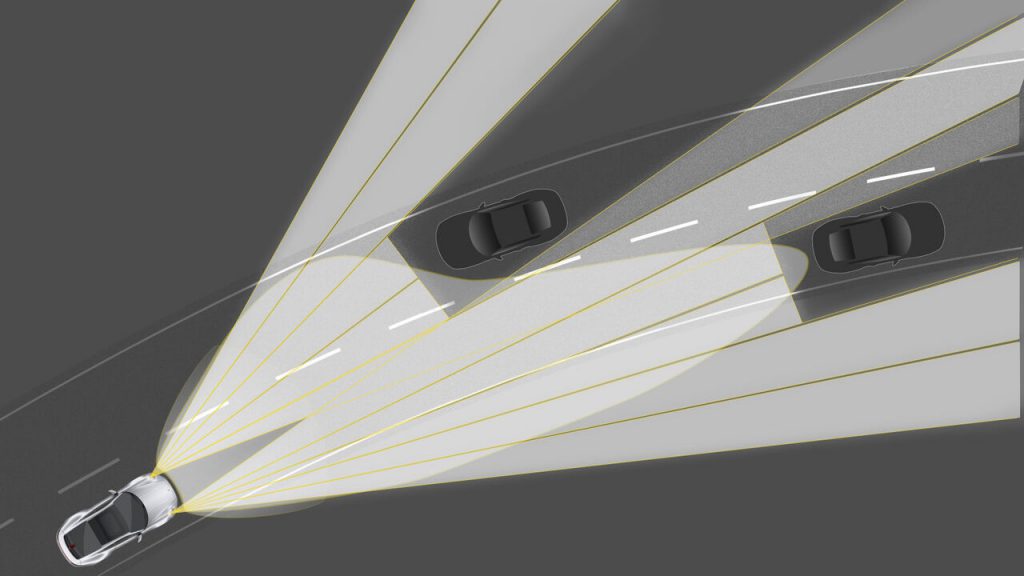AFS is an abbreviation for Adaptive Front-lighting System, which refers to headlights that swivel in the direction a vehicle is turning to illuminate more of the road ahead of the vehicle rather than straight ahead. Adaptive front lighting is a term used by a number of automakers, including Honda, Mazda, and Toyota. Other manufacturers have their own brand names for their adaptive headlights, such as the Genesis Adaptive Cornering System and the Porsche Dynamic Light System, and they are also known as adaptive headlights or curve-adaptive lights.
Contents
When Did It Appear?
Some historians attribute the first use of adaptive front lighting to the 1948 Tucker, a car with several innovative features that was never mass produced because the company failed after only 51 cars were built. The Tucker had two fixed headlights and a third in the center that pivoted in the direction the car was turning, dubbed the “Cyclops eye”. Some early-twentieth-century automobiles, however, had lights that pivoted via a mechanical link to the steering wheel. In modern, adaptive headlights first appeared on luxury models in the early 2000s. The technology, like other innovations, has spread to lower-cost brands such as Mazda, Hyundai, Ford, and Honda.
More Than One Types
Adaptive headlights are those that actively respond to changing conditions. Their goal is to give drivers better visibility and more time to react on the road. It’s a catch-all term for a variety of features, the most common of which are curve-adaptive headlights. These headlights have bulbs that pivot in accordance with the direction of travel of the vehicle—and sometimes speed. Other types of adaptation, such as automatic high beams, can also be referred to as adaptive headlights. In the presence of traffic, these headlights automatically switch between low and high beams. It’s also used to show adaptive driving beams. To avoid blinding other drivers, these headlights employ complex LED arrays.
Curve-adaptive Headlights

Curve-adaptive headlights have bulbs that turn toward the vehicle’s direction of travel. When the driver turns the steering wheel left or right, or when sensors detect curvature in the road, the headlights change direction to better illuminate what’s in the vehicle’s path. Some curve-adaptive headlights also change the angle of the bulbs according to vehicle speed, allowing them to project closer or further.
Curve-adaptive headlights use bulbs that are mounted on motors or servos, allowing the bulbs to pivot. When the driver turns the steering wheel or sensors detect a curve in the road, software or hardware adjusts the bulbs accordingly. When the vehicle’s direction returns straight ahead, the bulbs do as well. Some curve-adaptive headlights also adjust the angle of the bulbs in relation to speed. The headlights point more up or down as the speed changes, casting light closer or further down the road.
Cornering-adaptive Headlights
Cornering lights are fixed in place, as opposed to many curve-adaptive headlights that physically pivot the bulbs in the direction of travel of the vehicle. They turn on automatically when the steering wheel is turned or the turn signal is activated. The cornering light turns off when the driver returns the steering wheel to its center position or when the turn signal is deactivated. The goal is to temporarily illuminate the area in the direction of travel of the vehicle. Cornering lights have been used in automobiles for decades and are still used in some new models today.
Automatic High Beam
Automatic high beams are high beams that turn on and off without the driver having to do anything. Unlike traditional high beams, which must be activated manually, automatic high beams are activated by default. A sensor detects the lights of nearby vehicles, whether they are the taillights of vehicles traveling in the same direction or the headlights of vehicles approaching from the oncoming lanes. To avoid blinding those drivers, the sensor turns off the high beams. When there are no other vehicles in the area, the high beams are turned back on to improve visibility. Although vehicles with automatic high beams default to full brightness, they still allow the driver to manually control the low beams or high beams if, for example, they want to avoid blinding oncoming traffic in the split second between the car recognizing another vehicle and switching back to low beams.
Adaptive Driving Beam (ADB)

Adaptive driving beams (ADB) are a newer, more technologically advanced type of adaptive headlight. ADB lights are made up of many individual and very bright LEDs rather than distinct bulbs for low and high beams. The ability to precisely control the brightness of each LED distinguishes ADB headlights. When sensors detect other vehicles, the software responds by dimming the LEDs that project onto those vehicles. Meanwhile, the LEDs that are not shining on the other vehicles keep their full brightness. Each LED dynamically adjusts to the positions of other vehicles. As a result, there is a lot of light around those vehicles, but not so much on them. Consider ADB headlights to be illuminating what’s ahead while casting “shadow” on other vehicles to avoid dazzling their drivers.
SEE MORE:
Should you have it?
Adaptive headlights are making their way from high-end to mainstream vehicles, but they are not always standard. Choosing a system that aids in the avoidance of hazardous situations, on the other hand, appears to be a worthwhile investment. The ability to see a few feet further ahead, or slightly more around a corner, could make a significant difference. A preventable collision could cost far more than the adaptive headlight option.
According to a 2020 IIHS report, curve-adaptive headlights were linked to a 5.8 percent decrease in the frequency of property damage loss claims and a 1.1 percent decrease in the frequency of collision claims. It’s unclear how much of this reduction is due to adaptability or their brighter bulbs. However, there was a 4.7 percent increase in the severity of collision claims, as well as the average cost of claims made by owners of vehicles equipped with curve-adaptive lights.
There are some additional costs associated with adaptive headlights. If a headlight fails, it will be more expensive to repair than a standard equivalent. This is exacerbated by the possibility of sensor damage, which is typically located in the front bumper or behind the windshield. Even minor parking accidents or cracked windshields can result in costly replacements or recalibrations.
Conclusion
According to statistics, an accident is four times more likely to occur at night than during the day. This figure can be reduced by bringing advanced technologies that improve nighttime visibility. This broad range of AFS functions can be tailored to the specific needs of each automaker. These new features respond to both government and user demands for improved active safety while driving at night.
Many high-end manufacturers include or offer adaptive headlights on their vehicles. Porsche, BMW, Audi, Mercedes-Benz, and Volvo are just a few of the manufacturers that offer adaptive headlights on a wide range of their vehicles. Adaptive headlights are now standard on many mainstream vehicles. Ford, Subaru, Toyota, Hyundai, and Honda are among the automakers that offer adaptive headlights on even entry-level models. Each model year, the number of vehicles equipped with adaptive headlights increases.



